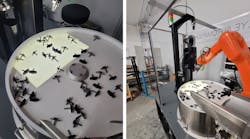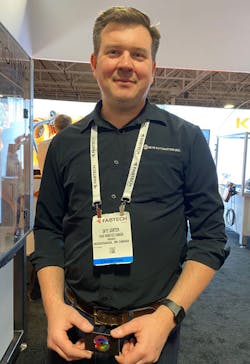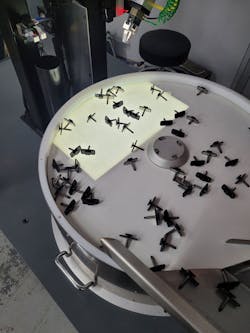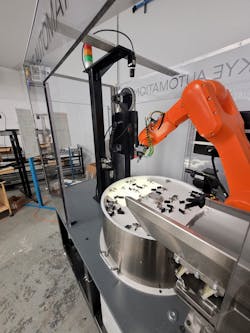Designing a Turnkey Vision-Guided Bowl Feeder Cell
At a Glance:
- Skye Automation Inc., an automated solutions provider for controls, electromechanical, safety, machine vision and sensor applications, orchestrates a turnkey bowl feeder system for an automotive component supplier.
- Skye Gorter, founder and president, Skye Automation, discusses the design considerations his team made to fulfill the requirements of a pre-built vision guided flexible automation cell.
- In this application, the design team opted to use a FlexiBowl that works in tandem with an industrial robot and a vision system.
READ MORE: FABTECH Canada 2022 Makes a Comeback After Four Years
On the surface, the job of sorting parts may seem like a singular exercise. In reality, it affects the entire scope of an assembly system. The installation of a parts sorting and feeder system is incomplete without modification and optimization of peripheral equipment.
Parts feeder systems serve a broad range of industries—from high-speed packaging, food and beverage, electronics and metal working to automotive and pharmaceutical—where volume and scalability are crucial. For small and medium manufacturers, a flexible system that can orient and feed multiple part styles is also a priority.
Short of manually feeding parts along a conveyor system, there are a range of automated feeding solutions, including vibratory bowl feeders, bin-picking and flexible feeding systems, and making the best choice is critical to the success of each project. Without exception, exceptional quality, high feed rates, reliability and easy maintenance are indispensable characteristics.
In a recent solution Skye Automation was tasked with configuring an end-to-end automated bowl feeder solution that could perform dimensional and quality inspections on a range of components for an automotive component supplier (Tier 2).
“The challenge was feeding,” explained Gorter. “Parts neither fed well through a traditional vibratory bowl, nor did [the client] have the high volumes to justify a vibratory bowl—because that would need a dedicated machine. So, we developed a specific application around the FlexiBowl that could feed various components into a standard inspection station and where we could do a dimensional check on the parts.”
Circular System
Unlike a vibratory feeder, a FlexiBowl is a flexible bulk feeder that consists of a rotating plate that relies on the combined actuation of a servomotor and a pulse generator to separate and feed parts. The patented brainchild of ARS Automation, an Italian supplier of automation systems, the bowl feeder is compatible with robots and vision systems and is suitable for facilities that have reduced volumes and frequent product changeovers and for applications where parts don’t feed well through a vibratory bowl. The FlexiBowl’s achieved feed rate is between 20 and 50 parts per minute and has a high payload, with parts total weight exceeding 7 kg, according to ARS Automation.
“The Flexibowl only ever becomes a component of the overall system,” explained Gorter, who co-founded his company with his wife, Rachel, in 2015. The company provided a way to channel Gorter’s machine vision integration experience and evolved to a machine design and build operation.
Drop, Separate, Pick, Recirculate
In a typical parts feeder scenario, a hopper drops parts onto the surface of a circular feeding bowl, which uses the principles of bidirectional rotation and an impulse generator to separate and stabilize parts. A vision system (camera) takes a photograph of the components before an algorithm identifies the location of the objects on the disc. These coordinates are relayed via communication ports (actuated via Ethernet or I/O) to a robot for the pick and place sequence.
Gorter pointed out that there is a trade off in the feed rate (it is “a little bit slower”) relative to a traditional vibratory bowl, but the added flexibility, by having one machine that’s capable of doing many different tasks, makes up for what it lacks in terms of speed rate. Skye Automation’s client was looking for a feeder system that could handle six different families of components, with a cycle rate of 10 PPM and with dimensional inspection functionality that could ensure components had been formed correctly before being picked and placed.
Alongside these specifications, their needs assessment revealed the design team would have to develop an automatic tool changer at the robot end, with a nest for component inspection. At the vision integration end, cameras oriented in two different directions would inspect parts with a high degree of repeatability and accuracy. “We’re running at about 50 microns for repeatability and dimensional accuracy,” said Gorter.
Process Dynamics
The process of configuring a flexible feeder system (which includes a robot, vision system and bulk feeder) is an analytical process broken down into several fields, said Gorter. “One field would be the vision requirements that are needed for the accuracy and range of products,” he said. “And then the mechanics are often geared towards what is required from the vision perspective.”
Stability and repeatability are two factors that affect the design of the vision system. “We want to avoid as much as possible ambient influences on the machine vision system,” said Gorter. In other words, how the parts feed, how they’re manipulated and how they need to move are all dependencies that play into the mechanical feeding system requirements.
For instance, autonomous runtime (the amount of time an operator can be away from the machine) can dictate some of the feeding requirements and the types and shapes of parts, which in turn affect robot orientations, as well as the end-of-arm tools required. “And then, what those parts have to be fed into would dictate the surrounding mechanics, as well as the safety considerations and guarding,” Gorter said.
For the flexible feeder system to work as intended, the vision system had to be calibrated to the robot. The vision software is not proprietary, but it is a standalone product for which Skye Automation has secured exclusivity in North America. The software, which Gorter’s team paired with GigE cameras, runs on a Windows IoT computer.
“The components are generic; we simply program the vision using pre-made tools that are designed for advanced machine vision functions,” said Gorter. “Additional capabilities are possible through scripting custom tools in MvTec’s HALCON software and adding them in for more specialized applications.”
From there, the team used industrial communications from the PC to the industrial components, which is typically Ethernet IP to the robot, and Ethernet IP to the FlexiBowl. The software interface becomes the master controller for the integration and communication between devices, said Gorter. Overall, his team was able to achieve a robust solution with a high degree of precision and reliability for the long term.
Quality and Throughput
Skye Automation’s design team also designed a multipurpose tool so the robot could be fitted with a gripper mounted to the end effector. A custom vacuum component designed for picking seals had to be connected to a stud.
The custom seal feeder uses tension for this application. “We call it tension on winder,” said Gorter. “We developed that to specifically feed the product, as well as vision guidance to detect the location of it. The robot is able to properly identify and pick the seal with a high degree of precision.” The ability to identify seal imperfections is an advantage that prevents the assembly of products that do not meet quality standards.
READ MORE: What’s the Difference Between Cobots and Industrial Robots?
Price Tag
Although the cost of building a turnkey solution depends on the project scope and the unique requirements, Gorter noted that a starting point is around $200K.
“In terms of value, that relates largely to many other factors,” he explained. “For example, in this application we eliminated the need for an operator, but we also provided a repeatable solution and high-quality assembly that is going to eliminate other expenses or costs that can be related to missed quality or errors in the assembly that would happen through a manual process. Those are often some of the bigger and unexpected expenses that can reduce profitability for a small company. Whereas, automating that gives you reliability of your manufacturing process—the process times as well as your quality.”
Depending on the machine, the requirements for commissioning and maintenance may differ, too. Skye Automation’s team is increasingly developing self-contained systems, allowing them to build, test and validate the system’s output before it is shipped.
Installation and Aftercare
One aspect worth noting, said Gorter, is how flexible and highly configurable these implementations can be. “We design and build it in such a way that it can be loaded onto a truck; it ships and is plugged into a wall and turned on,” he said.
Naturally, the project harnessed Skye Automation’s multi-disciplinary skill set—including software development, millwright, mechatronics and mechanical engineering—and Gorter credits them for their creativity.
“I’m really proud of our integrators and designers who came up with the concepts, because it’s very unique, it’s customized, but it’s also very functional and simple when you get down to the root of it,” he said. “In fact, the first system that we built like this went to a foreign customer. Due to COVID-19, we couldn’t visit them. So, we commissioned it remotely.”
When the customer later needed to implement new components to accommodate new parts handled by the machine, Skye Automation was able to seamlessly handle the request. “We had remote access to the machine, so we were able to implement new components that weren’t anticipated during the machine build phase,” he said.




